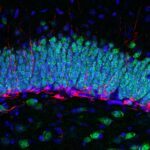Link to Pubmed [PMID] – 23284812
PLoS ONE 2012;7(12):e51910
Methylphenidate (MPH), commercially called Ritalin or Concerta, has been widely used as a drug for Attention Deficit Hyperactivity Disorder (ADHD). Noteworthily, growing numbers of young people using prescribed MPH improperly for pleasurable enhancement, take high risk of addiction. Thus, understanding the mechanism underlying high level of MPH action in the brain becomes an important goal nowadays. As a blocker of catecholamine transporters, its therapeutic effect is explained as being due to proper modulation of D1 and α2A receptor. Here we showed that higher dose of MPH facilitates NMDA-receptor mediated synaptic transmission via a catecholamine-independent mechanism, in layer V∼VI pyramidal cells of the rat medial prefrontal cortex (PFC). To indicate its postsynaptic action, we next found that MPH facilitates NMDA-induced current and such facilitation could be blocked by σ1 but not D1/5 and α2 receptor antagonists. And this MPH eliciting enhancement of NMDA-receptor activity involves PLC, PKC and IP3 receptor mediated intracellular Ca(2+) increase, but does not require PKA and extracellular Ca(2+) influx. Our additional pharmacological studies confirmed that higher dose of MPH increases locomotor activity via interacting with σ1 receptor. Together, the present study demonstrates for the first time that MPH facilitates NMDA-receptor mediated synaptic transmission via σ1 receptor, and such facilitation requires PLC/IP3/PKC signaling pathway. This novel mechanism possibly explains the underlying mechanism for MPH induced addictive potential and other psychiatric side effects.

